yeovil people
henry stiby
Ironmonger and Mayor of Yeovil
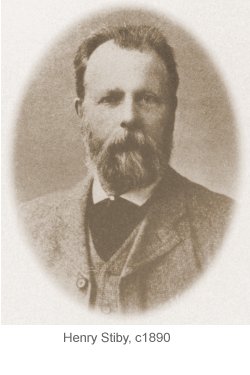 Henry
Stiby was born
in Acreman
Street,
Sherborne on 19
January 1843,
the fourth and
youngest son of
farmer Robert
Stiby
(1799-1866) and
Frances Moore née
Brook
(1813-1896).
Henry
Stiby was born
in Acreman
Street,
Sherborne on 19
January 1843,
the fourth and
youngest son of
farmer Robert
Stiby
(1799-1866) and
Frances Moore née
Brook
(1813-1896).
Robert Stiby (see Gallery) was very prosperous and moved his family to a large, 670 acre farm at Stalbridge called Park Farm. On his father's death in 1866, Henry took over the day-to-day running of the farm while in his very early twenties. Sadly, he didn't take to farming, so left the family farm and moved to Devizes where he became apprenticed to an ironmonger. It was clearly a short apprenticeship rather than the normal seven years, since he moved to Yeovil and established his own ironmongery business in partnership with the young Thomas Denner in May 1869.
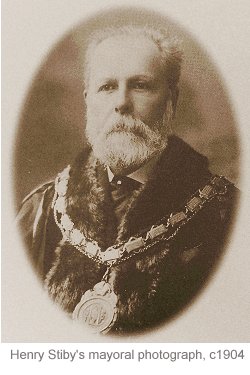 Denner had
served his
apprenticeship
at the
ironmongery of
Josiah Hannam
between
Wine
Street and
Tabernacle Lane
and it is
thought that
Denner and Stiby
established
their
'Furnishing and
General
Ironmongers'
business around
the time that
Hannam retired
in the mid-1860s.
The shop of
Denner and Stiby
was in the old
shop previously
run by
ironmonger
James Corfield on the site
of (and possibly
in the actual
building of) the old
George Inn in
High Street,
next to the
town
hall (see
photographs
below).
Denner had
served his
apprenticeship
at the
ironmongery of
Josiah Hannam
between
Wine
Street and
Tabernacle Lane
and it is
thought that
Denner and Stiby
established
their
'Furnishing and
General
Ironmongers'
business around
the time that
Hannam retired
in the mid-1860s.
The shop of
Denner and Stiby
was in the old
shop previously
run by
ironmonger
James Corfield on the site
of (and possibly
in the actual
building of) the old
George Inn in
High Street,
next to the
town
hall (see
photographs
below).
The first floor of their shop adjacent to the town hall was over the entrance to George Court, an alleyway connecting High Street with South Street before the building of King George Street.
When he moved to Yeovil Stiby, clearly affluent from the sale of the family farm, lived in a large house on the southeast corner of Peter Street and Union Street. The 1871 census lists him as a 27-year old ironmonger living there with his widowed mother and a young general domestic servant. Also in the 1871 census 31-year old Thomas Denner was recorded as living over the shop premises in High Street with his wife, two children and a domestic servant. On the census it stated Thomas' occupation as ironmonger and that the business employed two assistants and two boys.
In the 1881 census Henry and his mother had been joined by Henry's older brother Charles, a farmer, and his wife Sarah plus two domestic servants. By the time of the 1891 census Henry and his mother had moved to 10 The Park (now renumbered to No 17). By this time Henry was aged 47 and his mother was aged 76. His mother was presumably getting frail (she was to die just five years later) because as well as the cook and housemaid there was a new addition to the staff, a housekeeper / nurse, Louisa Mary Young. Henry, who remained a bachelor all his life, was to remain living in this house with Louisa until his death in 1934. Louisa died two years later aged 83.
Both Henry and his partner Thomas Denner retired in 1894 and their shop premises became Llewellyn's greengrocery and florist shop. It was subsequently bought by the council and demolished around 1927 for the construction of King George Street and the new municipal offices.
After his retirement from the ironmongery business Henry had more time to devote to his wide-ranging interests which included photography and he left a fine record of Yeovil and its surroundings from the 1880's onwards. He donated his collection of guns, coins, etc. to the fledgling Wyndham museum which was to become the Yeovil museum - all now sadly locked away in storage at the Community Heritage Access Centre and only viewable by appointment. He was involved with the church and was a Sunday school superintendent at the Reformed Episcopalian church of Christ Church in The Park, close to his home.
In 1902 he was elected to the town council and was elected Mayor in 1904 and became a Justice of the Peace in 1906. He became an Alderman in 1907 and retired from the council in 1909. In 1926 he was awarded the Honorary Freedom of the Borough of Yeovil in recognition of his services to the town and Stiby Road, formerly known as Lower Larkhill Road and Glyde Road, is named after him.
Henry died on his birthday, 19 January 1934, aged 91 and in his will left £18,898 (equal to over £1,150,000 at today's value) and left £50 a quarter (over £3,000 in today's value) and the use of his residence to his long-time companion Louisa Young. Henry is buried in the Preston Road cemetery with his mother and Louisa.

Henry Stiby's signature from an indenture dated 23 March 1889.
map
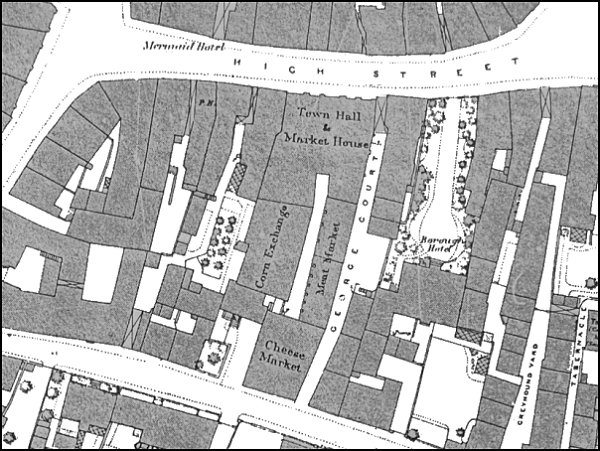
The 1886 Ordnance Survey showing the Town Hall & Market House, the Corn Exchange, Meat Market and the Cheese Market. George Court runs between High Street at the top of the map and South Street at the bottom and Denner and Stiby's ironmongery was the building in High Street immediately right of George Court.
gallery
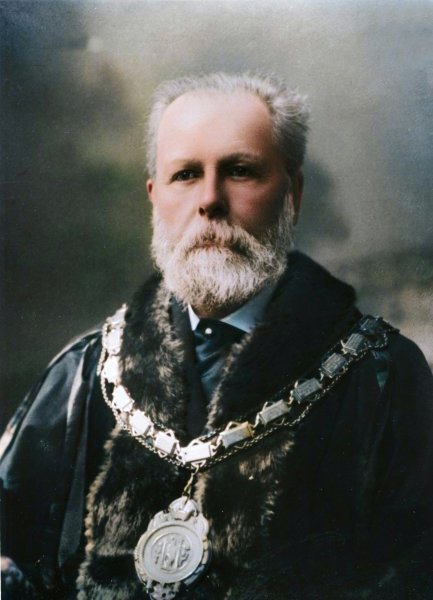
Henry Stiby
1843-1934
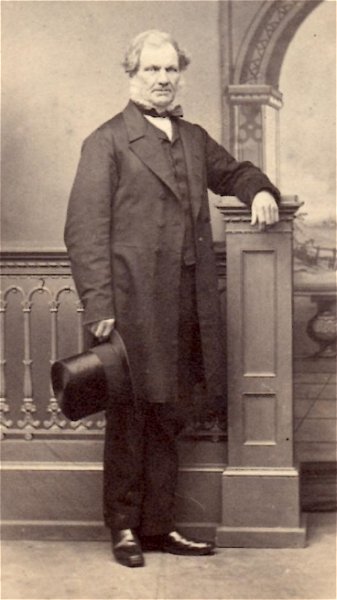
Courtesy of
Richard Scott
Henry Stiby's father, farmer Robert Stiby (1799-1866) of Stalbridge, Dorset, photographed by John Chaffin of Hendford.

Denner & Stiby's advertisement of 14 May 1869 in the Western Gazette informing the 'Gentry, Clergy, and Public generally' of their new enterprise.
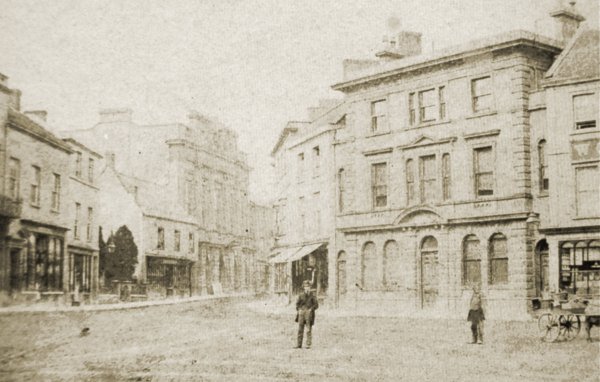
A very early photograph, dating to about 1860, shows High Street as seen from the Borough. Notice that at this stage the Town Hall lacks a clock tower which was not to be erected until 1864 but taken down in 1887 as unsafe. Henry Stiby and Thomas Denner were to purchase the shop next to it, previously the premises of ironmonger James Corfield, for their ironmongery business within the next decade.
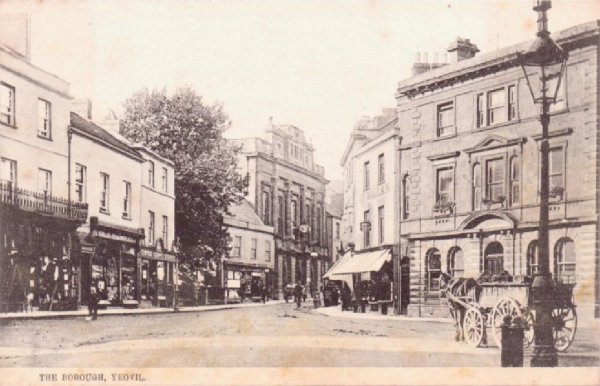
From my
collection
This postcard of the Borough dates to about 1905 and shows the former Denner & Stiby premises at centre, between the tree and the town hall. By this time both Henry Stiby and Thomas Denner had retired from the business and the shop was occupied by fruiterer James Llewellyn.
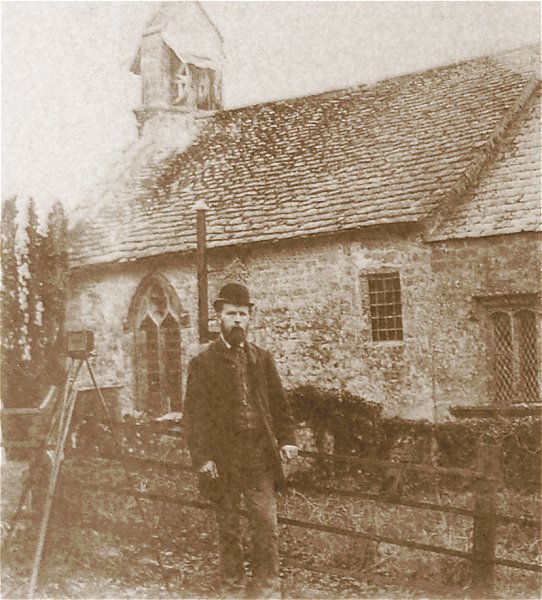
Henry Stiby, the photographer, on location with his camera and tripod at Thorne Coffin church during the late 1880's.
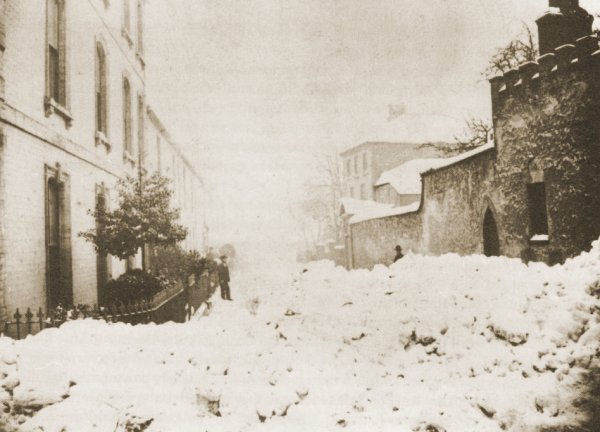
Courtesy of Rob
Baker
Peter Street blocked by 'The Great Snow' of 1881. This photograph was possibly taken by Henry Stiby - he lived in the house seen at extreme right, on the corner of Peter Street and Union Street, at the time.
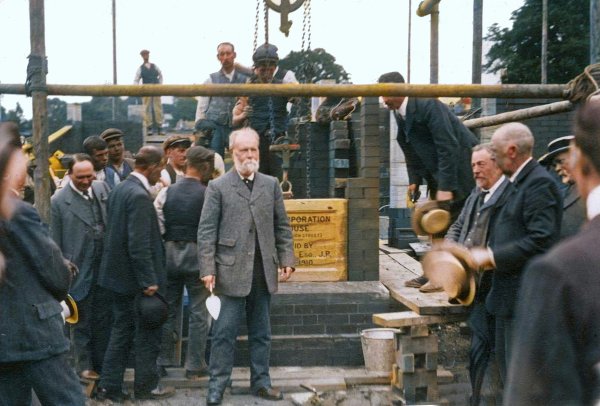
From the Stiby
Collection
(colourised).
Courtesy of South Somerset Heritage Collection
Henry Stiby, at centre holding trowel, having just laid the foundation stone of Dorcas House on 27 July 1910.
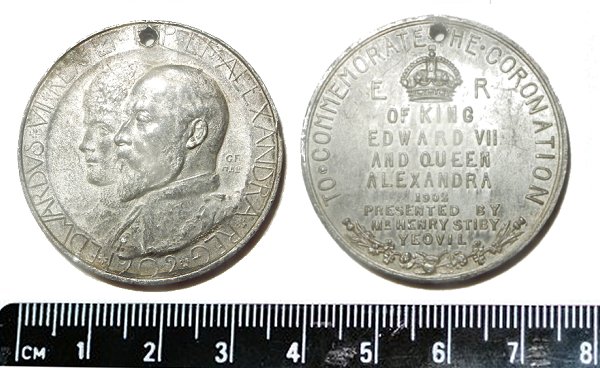
The above scarce commemorative medallion in my collection was given by Henry Stiby to commemorate the coronation of King Edward VII (reigned 1901-1910) and Queen Alexandra.
The medallion is 35mm in diameter and 2.5mm thick. The obverse carries profile portraits of the king and queen with "EDWARDUS VII REX ET IMP ET ALEXANDRA REG. 1902" around the edge. The reverse carries the edge inscription "TO COMMEMORATE THE CORONATION" and a central inscription reading "OF KING EDWARD VII AND QUEEN ALEXANDRA" over "1902 PRESENTED BY MR HENRY STIBY YEOVIL" below a royal crown motif between "ER". The edge is plain.
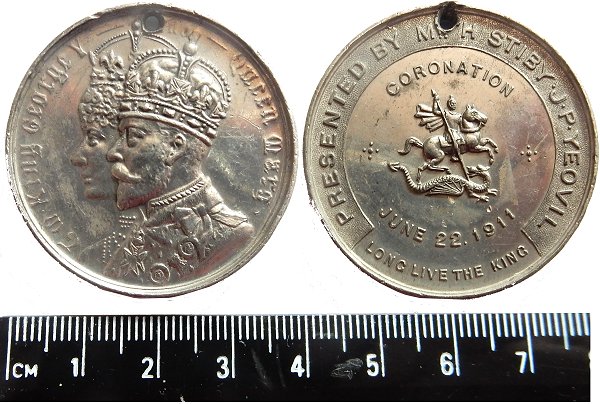
The above rare commemorative medallion in my collection was given by Henry Stiby to commemorate the coronation of King George V (reigned 1910-1936).
The medallion is just over 38mm in diameter and 2.8mm thick. The obverse carries profile portraits of the king and queen with "KING GEORGE" and "QUEEN MARY" around the edge. The reverse carries the edge inscription "PRESENTED BY MR HENRY STIBY JP. YEOVIL" and a central inscription reading "CORONATION" above and "JUNE 22 1911" below a central motif of St George and the Dragon. At the very bottom is "LONG LIVE THE KING".
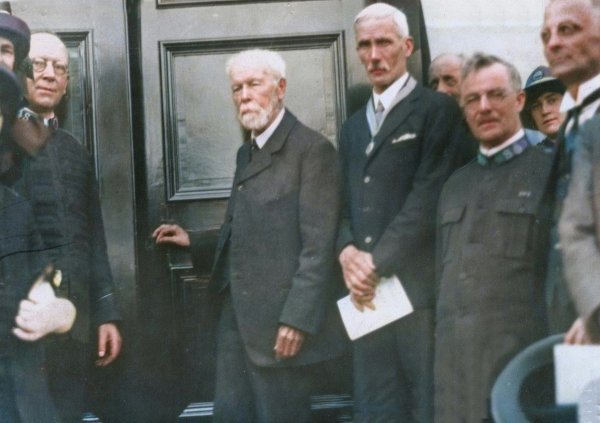
Henry Stiby, at centre, performing the official opening of the Salvation Army Hall in Southville in a colourised photograph of 1932, just two years before his death.
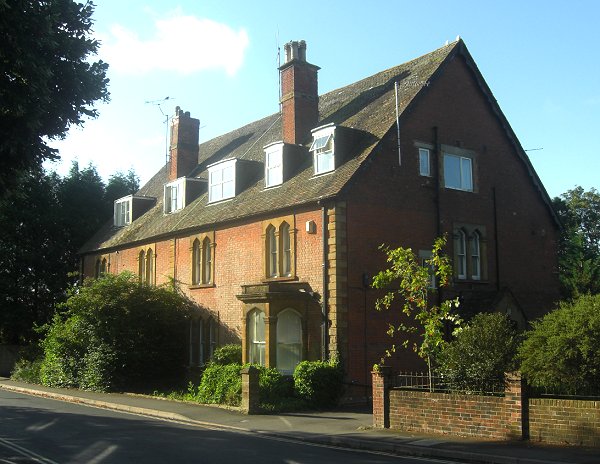
Henry Stiby's house in The Park where he spent the last 40+ years of his life. It is now the local Conservative Party headquarters. Photographed in 2013.
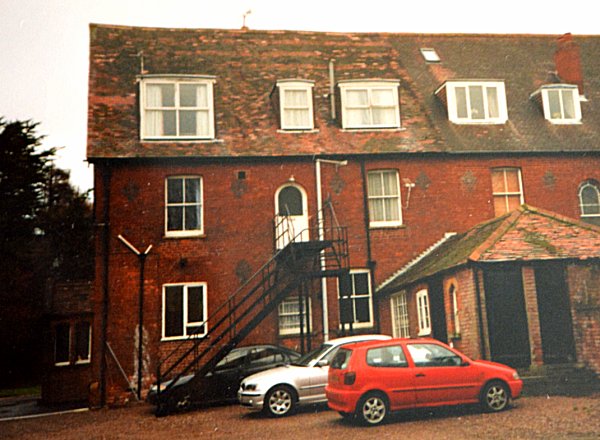
Courtesy of Bill and Audrey Robertson
The rear of Henry Stiby's house in The Park, photographed in the 1990s.
The Henry Stiby Photograph gallery
Henry Stiby was a keen amateur photographer and left a good record of Yeovil from the 1880s onwards. The photographs below, mostly Courtesy of South Somerset Heritage Collection, are in approximate date order.
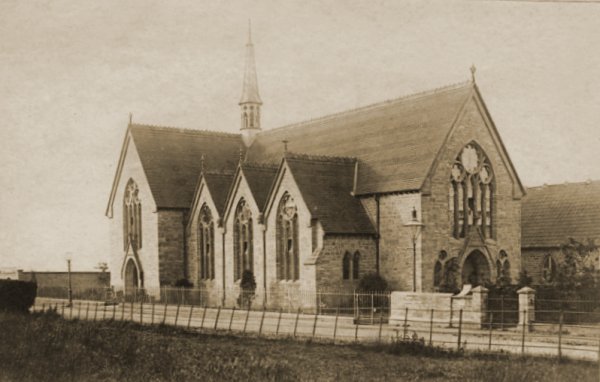
The Reformed Episcopalian Christ Church photographed by Henry Stiby, around the time of its opening around 1880.
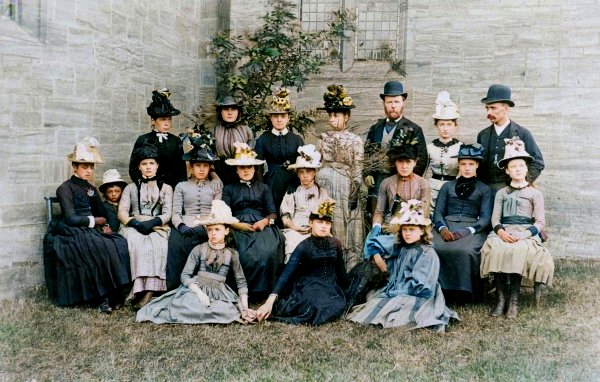
From the Stiby
Collection
(colourised).
Courtesy of South Somerset Heritage Collection
Another Stiby photograph showing Henry Stiby (back row, third from right) with friends, seated outside Christ Church c1880. He served for several years as Superintendent of Christ Church Sunday School.
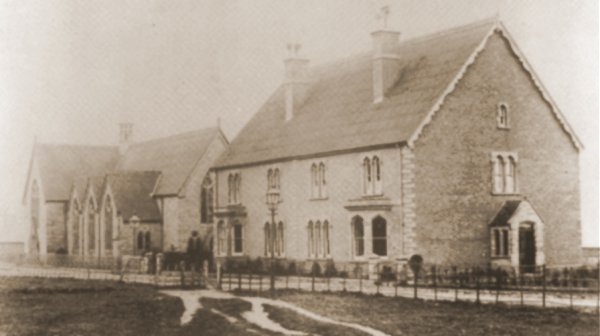
Another photograph taken by Henry Stiby around 1880 of the Reformed Episcopalian Christ Church in The Park soon after its construction. The church was demolished in 1905. The house at right was Stiby's own house in which he spent the final forty or more years of his life.
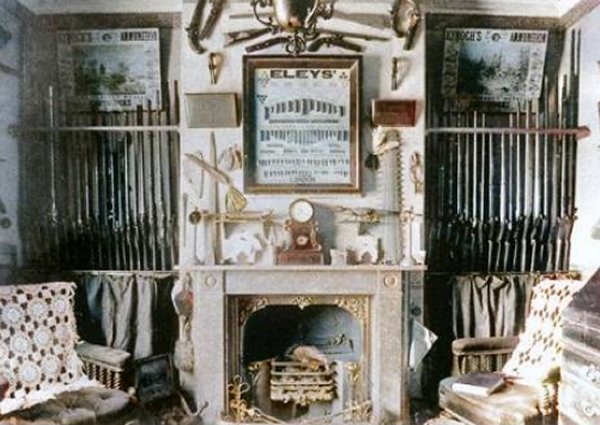
A colourised photograph of Henry Stiby's study at 5 The Park. His gun collection was donated to the Wyndham museum and is now, most sadly, locked away in the council's store at Lufton.
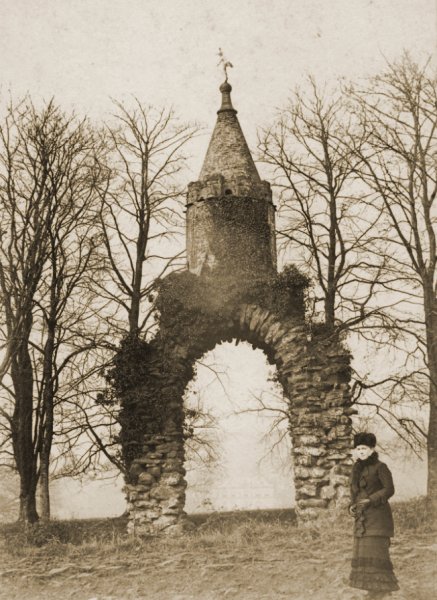
Jack the Treacle Eater photographed around 1880 by Henry Stiby.
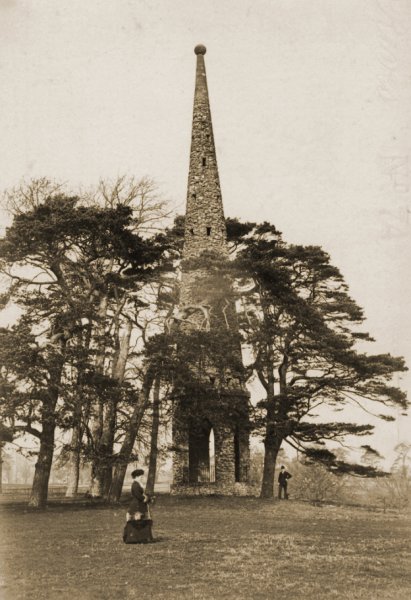
The Rose Tower photographed by Henry Stiby around 1880.
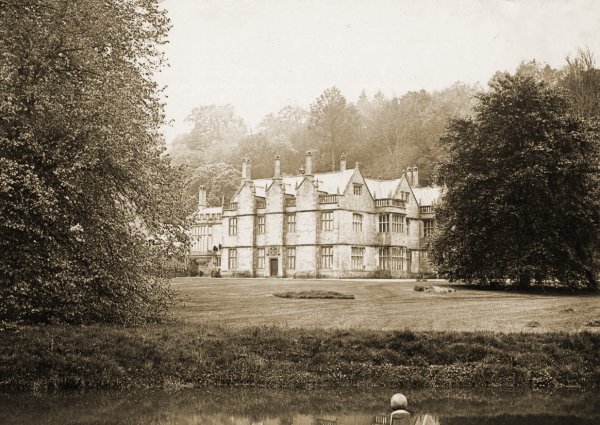
Newton Surmaville, probably photographed by Stiby in the 1880s from the banks of the River Yeo.
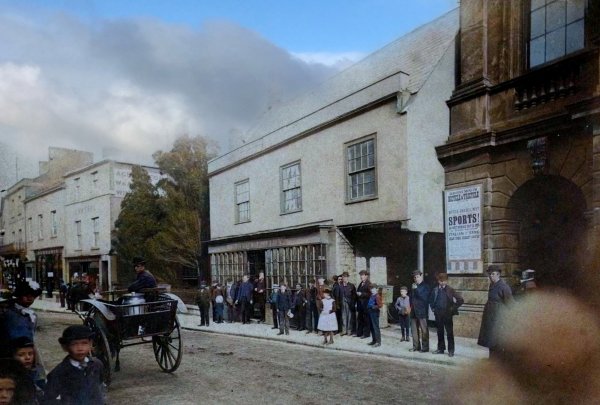
From the Stiby
Collection
(colourised),
Courtesy of South Somerset Heritage Collection
Denner & Stiby's shop photographed in 1883, by Henry Stiby himself who was a keen amateur photographer and left a good record of photographs of Yeovil. Note under the right of the three first floor windows is the entrance to the less-than-savoury George Court.
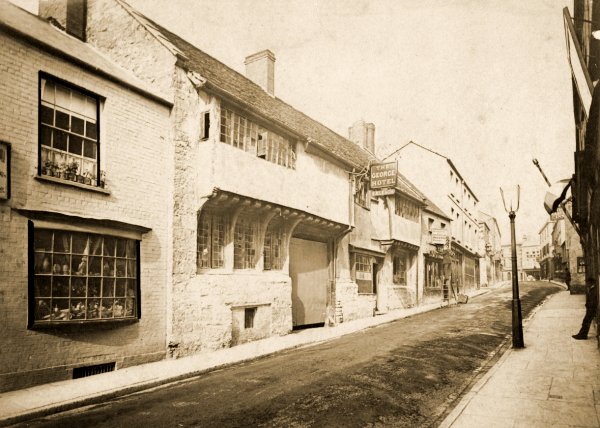
In this photograph, by Henry Stiby, of the mid-1880s (when Samuel Leach was landlord) the timber framing remains hidden but the name has changed from the George Inn to the George Hotel. The narrow width of the main London to Exeter road, less that twelve feet, is evident in this photograph.
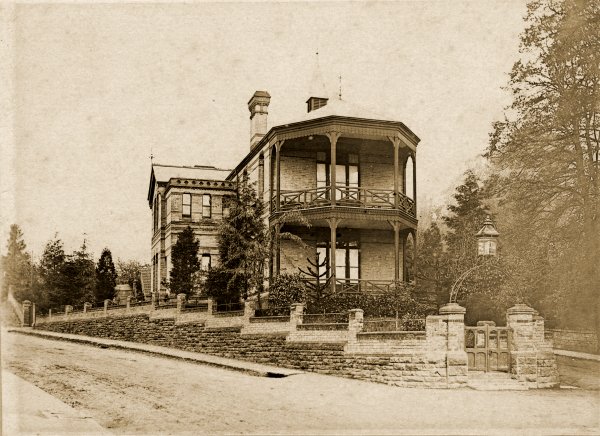
Fiveways Hospital photographed around 1885 by Henry Stiby.
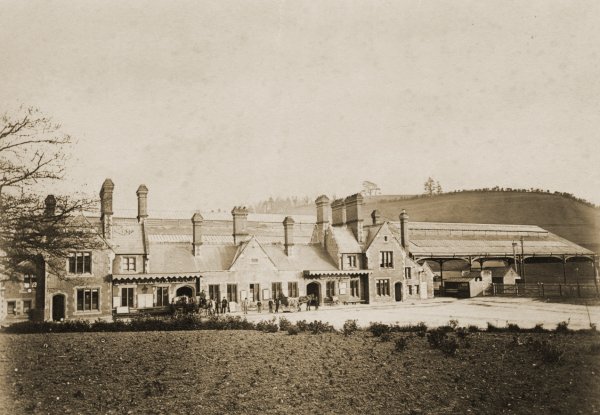
This photograph of around 1885, shows Yeovil Town Station with the fully-covered platforms to the right of the image.
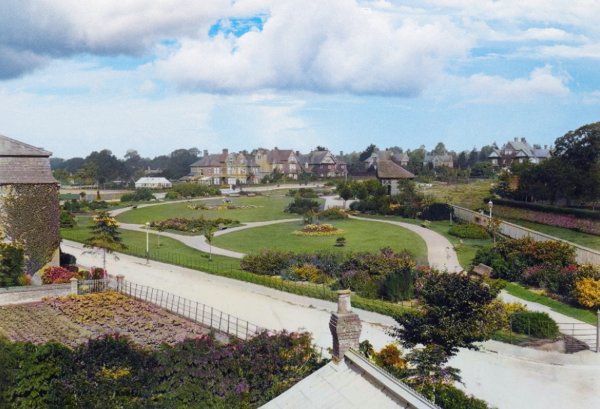
From the Stiby
Collection
(colourised),
Courtesy of South Somerset Heritage Collection
This is one of the first photographs of Sidney Gardens. It was taken by Henry Stiby from his bedroom window around 1900.
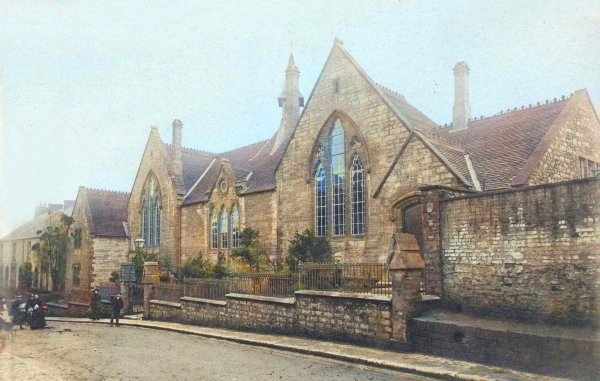
From the Stiby
Collection
(colourised).
Courtesy of South Somerset Heritage Collection
South Street School photographed around 1890 by Henry Stiby.
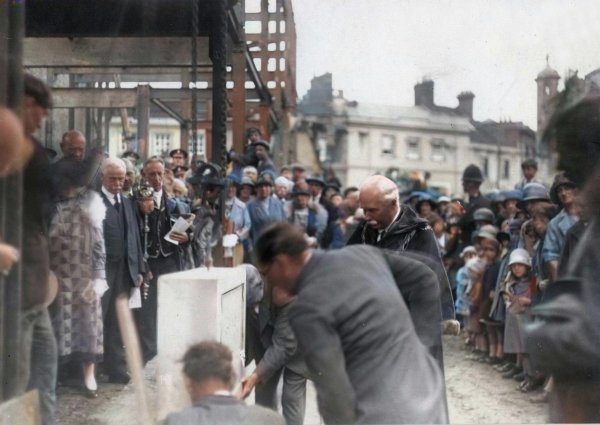
From the Stiby
Collection
(colourised),
Courtesy of South Somerset Heritage Collection
The foundation stone of the new municipal offices in King George Street is laid on 19 July 1926 by the Mayor of Yeovil, Alderman Percy Petter. Photograph by Henry Stiby.
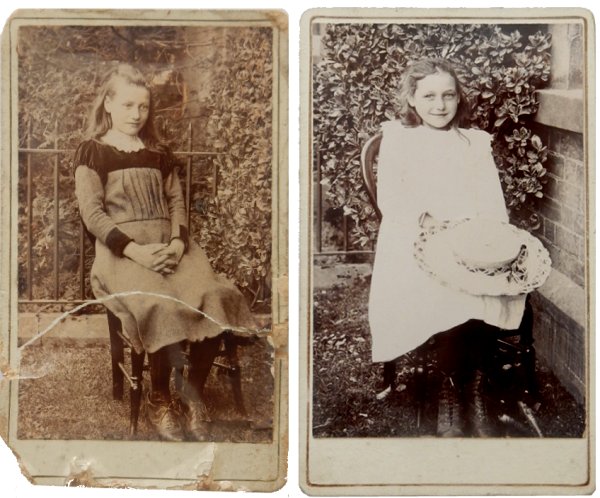
Courtesy
of Jack
Sweet
Cartes de visite by Henry Stiby, that to the left dated August 1898 and that to the right dated July 1904 - both are signed "H. Stiby" on the backs but carry no other mark and are thought not to be commercial portraits. Jack Sweet has pointed out to me that many of Henry Stiby's carte de visite and other portraits are of young girls and are possibly part of this lifelong bachelor photographer's personal "Gentleman's collection".
